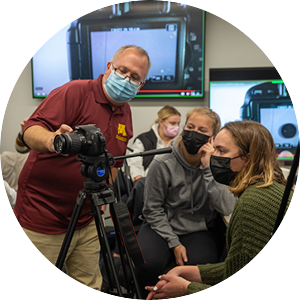
Addressing the disconnect between farm and fork
By Frances Homans

You can’t turn on the TV or scroll social media without seeing ads from food companies espousing how consumers should feel good about eating their products. From ethically raised animals, to environmentally conscious supply chains, to increased transparency about ingredients – consumers have more information at their disposal than ever before.
Yet there remains a disconnect between farm and fork. A recent consumer survey* shows that only 24 percent of U.S. adults have a high degree of trust in the information they receive about where their food is grown and how it is produced. For Generation Z (ages 18 to 25) the high trust level is just 17 percent. And with only 27 percent of survey respondents reporting a “very favorable” impression of agriculture and food production in the U.S., it is no surprise that farmers often feel misunderstood and under attack in the public eye.
At the University of Minnesota College of Food, Agricultural and Natural Resource Sciences (CFANS) we believe there is an urgent need to bridge this disconnect while at the same time investing in science-based solutions and dynamic partnerships to create a more sustainable global food system.
For the past nine years I’ve been fortunate to head up the Agricultural Education, Communication and Marketing unit within CFANS. Our mission is to prepare students to be successful leaders, educators, and communicators in the agricultural, food, and natural resources career field. This includes teaching them how to talk about their work in a way that’s clear, relatable and engaging.
One of the most exciting ways we’ve been able to do this is through our AgriCast project, thanks to funding from the CHS Foundation. AgriCast is a digital resource library dedicated to sharing science concepts and stories about agriculture. Here you can take virtual field trips to real farms, hear podcasts that challenge assumptions or explore a video library on topics including food and culture, microbes, and women in agriculture. The resource center also includes lesson plans and other educational activities to help teachers easily integrate our students' videos, photos, and podcast stories about farms, food, and the environment into their classrooms. It’s all created by our talented CFANS students in an effort to hone their communication skills while shedding light on complex topics involving the food chain.
At CFANS our goal is to prepare the next generation of leaders to sustainably solve the biggest challenges of a rapidly growing world. Doing that requires equipping people to teach our kids about agriculture, food and natural resources (AFNR). The demand for AFNR teachers is increasing, including in urban areas. According to the Minnesota Agricultural Education Leadership Council, since 2010, school districts have added 21 AFNR programs and 83 additional teaching positions had to be filled across the state. This is a 38 percent increase in teaching positions over ten years, with no signs of demand slowing. CFANS is proud to be a leader in educating AFNR teachers to help meet this critical need.
AFNR education is important because worldwide, agriculture and the economy are intricately linked. Here in Minnesota, farms generated 16.7 billion dollars’ worth of agricultural production last year with farm products accounting for nearly one-third of the state’s total merchandise exports in terms of value. However, the story doesn’t start and end at the farm gate. It’s why the department that I lead at UMN has evolved over the last century from focusing solely on agricultural production to become the Department of Applied Economics. Our research looks at the entire food system within the global economy, the economic effects of natural resource use, the importance of ecosystem services, and more.
As economists, we aim to understand the crucial role that efficiency plays in policy choices. “Efficiency” may not sound exciting, but it’s about finding win-win solutions. Whether it’s about using big data to target spending on agricultural research or designing food assistance programs to encourage healthier food choices, identifying efficient policy choices enables us to get more benefits from public budgets and keep tax burdens low.
Where our work may be most visible is at the consumer end of the supply chain. For example, my colleagues Metin Çakır, PhD, and Hikaru Peterson, PhD, are leading research that examines the economic viability of grocery stores in rural areas. Another project looks at how farmers fare when selling their goods at Twin Cities farmers’ markets. Peterson is also examining the economics of household food waste, studying how consumers engage with curbside organic recycling programs in Minneapolis suburbs.
It’s all an effort to better understand the interactions that happen along the food supply chain that ultimately impact the economy and the environment. As we equip future leaders to do this important work, we must continue to help them communicate about the value this research provides.
CFANS is a safe, open place to have the conversations that will turn disconnect into understanding. We will continue to pioneer the way forward, driving science, outreach and education throughout the entire food supply chain — from the soil and seeds in the ground all the way to the consumer’s plate.
Frances Homans, PhD, is professor and head of the Department of Applied Economics. She also leads the Department of Agricultural Education, Communication and Marketing.
*This CFANS survey was conducted in January 2022 by ENGINE INSIGHTS, polling a demographically representative sample of 1,022 adults (ages 18+) in the United States.









